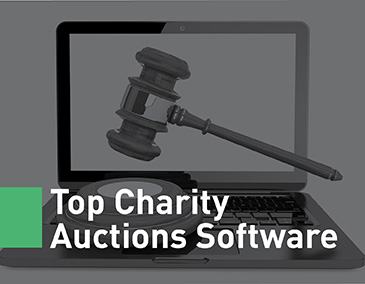Supercharge your silent auction with workplace giving opportunities.
Silent Auction Formats
Bid Sheets
When most people think of silent auctions, bid sheets come to mind. They’re simply pieces of paper placed next to each auction item that include spaces for participants to write their names, contact information, and bid amounts.
If your organization would prefer to host a more traditional silent auction, bid sheets might be right for you. Plus, since they don’t require any technology, physical bid sheets are a reliable way to collect bids on auction day.
Mobile Bidding
Mobile bidding has added a modern technological twist to silent auctions. With mobile bidding software, auction attendees can peruse items and place bids on their smartphones. They can either bid manually or set a maximum bid amount so that the software bids for them!
Since mobile bidding is so convenient, incorporating it into your silent auction can increase your event donation revenue by up to 30%. Additionally, since guests pre-register their credit cards, mobile bidding simplifies the checkout process.
Budgeting for Silent Auctions
Some common silent auction costs you’ll likely need to factor into your event budget include:
Though silent auctions are quite profitable, they can be relatively complex to plan. There are a lot of moving parts you need to ensure that your auction runs smoothly. As such, your organization needs to set a firm budget that accounts for all potential expenses. Ideally, your organization will fulfill as many of these needs as possible through in-kind donations, but leave room in your budget to ensure you can pay for them if necessary.
Investing in Silent Auction Software
Managing every aspect of an auction, from item procurement to mobile bidding and ensuring a seamless donor experience, can quickly become overwhelming without the right tools.
That’s where auction software comes in—helping organizations streamline operations, increase engagement, and maximize fundraising potential.
Lucky for you, there are a lot of excellent platforms to choose from. We’ll outline a few leading platforms to consider below!
Not to mention, auction software automates many of the time-consuming tasks involved in running a silent or online auction. Here’s how it can benefit your organization:
Auction Software Recommendation: Auctria
Auctria is a robust and budget-friendly auction platform designed for organizations of all sizes. It supports online, silent, and live auctions with a user-friendly interface and powerful tools for managing bids, payments, and donor engagement.
Key Features
- Customizable event websites for online auctions
- Mobile bidding and real-time bid tracking
- Integrated payment processing and automated invoicing
- Detailed reporting and analytics
Auction Software Recommendation: CharityAuctionsToday
CharityAuctionsToday offers a simple yet powerful platform for running online, mobile, and in-person auctions. It’s known for its ease of use and quick setup, making it an excellent choice for organizations that want a hassle-free solution.
Key Features
Auction Software Recommendation: Silent Auction Pro
SilentAuctionPro is an all-in-one fundraising solution tailored for nonprofits hosting silent and live auctions. It offers a full suite of tools, including event ticketing, table management, and bidder tracking.
Key Features
Recruiting an Auction Team
Logistics Committee
- Duties: The logistics committee, headed by the auction chair, will manage all logistics related to planning and promoting your auction. For example, they’ll book the venue, send invitations, and coordinate supplies.
- Job Description:The procurement committee should consist of outgoing individuals with extensive networks they can leverage. They should be excellent communicators who aren’t afraid to ask for the items your organization needs!
Procurement Committee
- Duties: The procurement committee will seek out in-kind donations of silent auction items. Provide them with a toolkit to help them ask for donations and know what items to request.
- Job Description: The procurement committee should consist of outgoing individuals with extensive networks they can leverage. They should be excellent communicators who aren’t afraid to ask for the items your organization needs!
Emcee & Auction Monitors
- Duties: The emcee hosts the silent auction and engages guests throughout the night. Auction monitors stand near the item displays, ready to address attendees’ questions and help the emcee keep the auction on track.
- Job Description: Emcees and auction monitors should be enthusiastic people who can be assertive when necessary. After all, they might have to re-emphasize the rules to guests from time to time!
General Volunteers
- Duties: Your organization will need a team of general volunteers to handle various tasks during your silent auction. For example, this team will set up the venue, run registration and item checkout, clean up after the auction, and complete other tasks as needed.
- Job Description: The general volunteer team should include volunteers with various interests and skill sets. They’ll be taking care of miscellaneous tasks, so diversity is key.
Selecting a Venue
Space
Considering that your organization will need to showcase dozens of auction items, the silent auction venue you choose must have plenty of open space for laying out tables, item displays, and other event stations.
Not to mention, it must be large enough to (comfortably!) accommodate your guest list.
Ambiance
The venue you select should reflect the ambiance you’re trying to create. Consider the theme of your auction and the main demographics of your guest list when narrowing down venues. For example, it would make more sense to host a family-friendly, back-to-school night auction in the school gymnasium or a local park than at a fancy art museum.
Accessibility
Chances are, some of the items featured in your auction are large or cumbersome. The venue you choose should be accessible with elevators, ramps, and wheelchair-accessible entrances so that it’s easy for your auction team to transport items. Plus, an accessible venue ensures all guests can easily enter and exit the building.
Strong Internet Connectivity
If you’re using auction or mobile bidding software for your event, your organization should select a venue with strong internet connectivity. Before booking, test out the Wi-Fi and cell service to make sure it’s reliable.
Soliciting Auction Items
To raise as much money through your auction as possible, it’s crucial to solicit your silent auction items strategically. We recommend following this sequence of auction procurement strategies:
- Start by soliciting in-kind donations. Your organization is likely already familiar with the process of soliciting and accepting in-kind donations. In-kind contributions are ideal for a silent auction because they allow you to source the items you’re looking for directly from your supporters without allocating any of your nonprofit’s funds.
- Seek out nonprofit discounts. Once you’ve gathered in-kind donations, fill in the gaps in your silent auction item offerings by seeking out nonprofit discounts. Many businesses are willing to sell their products or lend their services to nonprofits at a discounted rate.
- Work with a consignment travel provider. Take your silent auction items to the next level by enlisting the help of a consignment travel provider. They’ll help you curate unique auction travel packages that are sure to excite your donors and inspire bidding wars.
Before you begin the solicitation process, make sure to get to know your audience. That way, you can cater your silent auction items to their interests and preferences. However, there are some tried-and-true auction items that every crowd is sure to love. Our charity auction item guide recommends soliciting crowd-pleasing items such as:
Once procurement is complete, organize item details, such as thorough item descriptions and starting bid amounts, so bidders can easily access them. You may put this information on your bid sheets or host it on your auction software.
Promoting Your Auction
How Do You Promote a Silent Auction?
When promoting your silent auction, it’s important to advertise both the auction items and the event itself. After all, donors will be more inclined to attend if they spot an item they want to win!
The best way to promote items is by creating an auction catalog, which includes photos and descriptions of each item. To create your catalog, enlist the help of auction or event planning software.
Using this software, you can develop item records and pull this data to populate an event landing page or microsite branded to your silent auction. To promote your event, share the link to your site with your supporters via email, text messages, and social media.
Why Create an Online Auction Catalog?
Your organization could certainly compile and print a physical auction catalog, but it’s more cost-effective, efficient, and environmentally conscious to create one online. You won’t have to waste money on printing costs or worry about the logistics of mailing out your catalog to supporters.
Plus, you can continuously update your auction site. That means you can easily add new items as they come in, allowing you to start promoting your event earlier than you would be able to with a printed catalog. This is especially effective for silent auctions since your item list will likely be much longer than it would be for a live auction and therefore subject to change more before the event.
Not to mention, auction sites also support online bidding, so you could even choose to pair your silent auction with an online auction to raise even more money!
How Can You Boost Silent Auction Registrations?
There are several channels you can use to drive traffic to your event registration page, such as:
- Text messages
- Direct mail
- Social media
- Google Ads
If you choose to leverage Google Ads, partner with a Google Grants manager to create ads that target keywords potential attendees would likely search, such as “charity auction near me” or “fundraising event for [your nonprofit’s cause].” Professionals know how to use features like geotargeting so your advertising prioritizes local audiences. Getting your account up and running can take some time, so make sure to reach out well ahead of your silent auction.
Ready to promote your silent auction on Google?
Setting Up a Silent Auction
Group Items into Categories
To create the most intuitive display, group your items into categories. For example, you may have categories for travel-related items, baskets, and food and drink, just to name a few.
Not only will this make it easier for bidders to find the items they came to your auction to bid on, but it will also make it easier for your staff to retrieve items and distribute them to winners at the end of the night.
Promote Traffic Flow
Since there are so many items to display, silent auction venues can quickly become cluttered with tables.
Make sure you arrange tables in a way that promotes good traffic flow so that guests can easily check out (and bid on!) your items. Rather than U-shaped arrangements, which can quickly jam up, arrange your tables in spaced-out parallel rows to make them easy to browse.
Ensure Items Are Visible
For your items to have maximum appeal, your guests must be able to view them in their full glory!
Try to arrange items in only one row per table so guests can easily see them. Also, put your most valuable items at the ends of each table to make them impossible to miss as supporters walk by!
Create Display Sheets
To help donors see the full value of your items, and thus spur more bid activity, you should place display sheets next to each item.
Display sheets should list the item name and number, a brief description, any restrictions (such as an expiration date on a gift card), the market value, and the starting bid and minimum increase amounts.
Following Up After the Silent Auction
Express Your Thanks
The success of your silent auction truly depends on your attendees, item donors, corporate sponsors, volunteers, and other supporters. Make sure to thoroughly express your thanks to all pivotal contributors in a timely manner to keep fostering strong relationships with them.
An easy way to quickly show your appreciation for your silent auction stakeholders is by using eCards. Create an eCard branded to your organization that thanks stakeholders for their support. Then, personalize your eCards with each stakeholder’s name and specific involvement in your event, and send them to show how much you care!
Evaluate Your Performance
After your auction has ended, run reports with your auction software, and survey volunteers and attendees to gain insights into your event performance.
Evaluating your performance is crucial because it allows you to identify areas for improvement and build on the strengths in your event fundraising strategies for next time.
Strategies for Raising More at Your Silent Auction
Team Up with Corporate Sponsors
Corporate sponsors act as allies during event planning and execution by providing your organization with funding, in-kind donations (think: auction items!), additional promotion, and other advantages.
In return, your organization offers them advertising in event materials and the positive reputation boost that comes with supporting a good cause.
Because of the fiscal support they can provide, corporate sponsors can help your organization achieve a higher return on investment (ROI) for its silent auction.
Conduct a Live Appeal
A live appeal is simply an in-person ask for donations. At the beginning of your auction, have one of your staff or board members get up and request that the audience help you meet your fundraising goal.
You can collect donations using mobile bidding software, paper pledge cards, or a text-to-give service.
Any way you spin it, a live appeal is the perfect opportunity for guests who aren’t actively bidding (or those who just want to give more!) to contribute to your cause.
Host a Crowdfunding Campaign
During crowdfunding campaigns, nonprofits aim to reach a clear-cut goal to fund a specific cause or project. They do so by collecting small donations from a large number of donors.
To raise more at your silent auction, consider hosting a crowdfunding campaign before the event. You can use a crowdfunding platform to set up a personalized page and easily share it with your network over email and social media.
Sell Merchandise
Selling t-shirts, water bottles, and other branded merchandise can be an excellent way to supplement your silent auction proceeds.
Set up an online storefront on your event site and/or a physical merch booth at the event where guests can purchase items as auction mementos.
Many people attend silent auctions looking to walk home with a cool item, so branded merchandise is sure to please!
Additional Auction Resources
Silent auctions are an excellent fundraising tool when executed with thoughtful planning and strategic engagement. By curating desirable auction items, leveraging technology for seamless bidding, and promoting the event effectively, your organization can boost participation and maximize revenue. Most importantly, a well-run silent auction not only raises funds but also strengthens donor relationships and increases community support for your cause.
Whether you’re hosting your first silent auction or looking to refine your approach, following best practices will set you up for success. With the right preparation and execution, your silent auction can become a key fundraising event that continues to grow year after year.
Good luck!
Charity Auctions Guide
Silent auctions aren’t the only type of auction that your organization can host!
Check out this guide to learn more about charity auctions and how you can raise more money.
Charity Auction Software
It’s hard to run an auction without software.
If you’re in the market for charity auction software, make sure to take a look at our list of leading software providers.
Auction Item Ideas
You’ll need silent auction items to sell off to your bidders and supporters.
Take a look at these awesome charity auction item ideas to get some auction inspiration!






